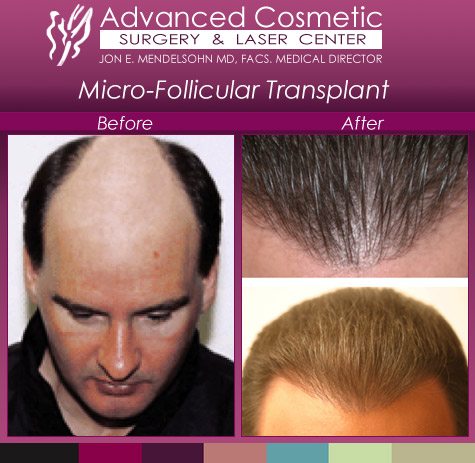Addresses the following concerns
- Hair loss
- Desire to treat bald spots and to gain a fuller head of hair
Hair Transplant Animation Videos
Hair Transplantation
Hair loss can be the result of multiple factors, primarily caused by a combination of aging, hormonal changes, and genetics. There is more than one technique that can be used to improve your appearance, which will be selected based on the extent of your hair loss.
During an initial consultation with our team, your head and scalp will be assessed, and you will learn which hair transplant technique will meet your desired results. The goal of hair transplant surgery is to use your existing hair in an efficient manner so that your balding areas can be restored.
Ideal Candidates
Whether male or female, in order to qualify as an ideal candidate for hair transplant surgery, you must have healthy hair growth at both the back and sides of the head. These will serve as donor areas (places on the head where grafts are taken). Some of the other factors that will be taken into consideration include hair color and texture, such as waviness or curliness. These may affect the overall aesthetic result.
Ideal candidates for hair transplant surgery must also be healthy with no medical causes of hair loss and have realistic expectations and goals.
Costs
Fees can range from 2500.00 to 15,000 per session.
The patient will be evaluated during the consultation. Many things will be looked at including they type of hair, size of hair loss area, desired aesthetic outcome and type of technology used. Deciding to have a hair transplant is not as easy as shopping for a new car online. Because there is such a wide difference in skill sets, the old saying is true “YOU GET WHAT YOU PAY FOR”
Our office provides the best of everything:
- Double Board Certified Facial Plastic and Reconstructive Surgery/Otolaryngology
- Fully Accredited Surgery Center
- Awarding winning team/technicians
- Leaders in technology
Recovery
It is common to experience some mild discomfort and tenderness over the scalp after hair transplantation surgery, which can be alleviated with prescribed medication if necessary. Any wigs or hairpieces should not be worn for at least the first two weeks after surgery. There are multiple factors that will affect how quickly you are able to go back to your regular routine, such as the length, complexity, and type of hair replacement surgery you underwent as well as the type of work you do. It may take several days before returning to work and resuming normal, light activities. If stitches or surgical clips are used, they are removed 9-10 days after surgery.
Because it could take several weeks for the grafts to become firmly implanted to the scalp, you must be extra careful while grooming your hair. The hair can be rinsed gently with a baby shampoo/water mixture. By day 10 you are typically out of danger of damaging the grafts, however sunburns should be avoided for 90 days.
The Results of Hair Transplant Surgery
Hair transplant surgery offers a successful outcome, but it will take time to see the full results.
Within the first several weeks after surgery, many of the transplanted hairs will fall out — a process that normally follows this type of procedure. After the hair falls, it typically begins to regrow after 3-4 months have passed. You may anticipate about a half-inch of growth per month thereafter.
Depending on the degree of hair loss, in order to achieve optimal, natural-looking results, additional surgery may be required. Healing between surgeries usually takes several months. During the consultation, we can discuss the details of any potential follow-up procedures.

Hair Transplant Techniques
Follicular Unit Extraction
The follicular unit extraction (FUE) method has turned into the most used technique at our practice. Like FUT, follicular unit extraction can effectively recreate a natural pattern of hair in the patient’s balding or thinning areas. This procedure requires the back of the scalp and sometimes above the ears to be shaved to the skin surface. Each follicular unit is then removed with our Advanced Smart Graft device that harvests the grafts with great efficiency and care. Grafts are removed in a manner that allows the extraction sites to be completely hidden once the shaved hair over the back of the scalp regrows. During the procedure, the hairline and recipient sites are made by what we call micro injection incisions matching the exact number of grafts to be transplanted. Soon thereafter, the grafts are placed into the sites using micro-forceps. The grafts are placed in precise positions; single hairs are placed in the front to recreate a natural-appearing hairline, and the remaining larger grafts which we refer to as Mendelsohn Multiples are placed behind the hairline to provide greater density and thickness in the recipient area. With our Smart Graft System we can relocate just as much hair as the FUG or strip method. This technique requires no scalpels or sutures and has a very swift recovery period.
Follicular Unit Transplantation
This method often called the “Strip” or “FUG” was once considered the “Gold Standard” by surgeons worldwide and to a certain degree, still is for those clinics who have not kept up with the technology. However due to the cutting of the “strip” out of the back of the head, sutures, linear scars and longer recovery period, FUT (“follicular unit transplantation”) technique is not as desirable as it once was now that the “Smart Graft System” has come on the scene.
The strip method is often times more economical and provides natural results and entails several steps. First, the hair at the back of the scalp is cut short within the donor area, but the surrounding hair is not trimmed. The precisely planned scalp section is then surgically excised, and the wound created by the incision is then closed with either stitches or surgical clips. The excised part of the scalp is divided into sections and placed under several magnifying lenses, during which time technicians will separate grafts into units of one to four hairs using sharp blades. During this time, the creation of the hairline and recipient sites are made by making tiny incisions matching the exact number of grafts to be transplanted. Soon thereafter, the grafts are placed into the sites using micro-forceps. The grafts are placed in precise positions; single hairs are placed in the front to recreate a natural-appearing hairline, and the remaining larger grafts are placed behind the hairline to provide greater density and thickness in the recipient area.
Most individual hair micro-graft restorations, such as the strip method, are performed on an outpatient basis and involve the use of local anesthesia.
Eyebrow Hair Transplantation
Similar to hair loss on the scalp, both men and women can benefit from the eyebrow hair transplant procedure. Eyebrow hair loss can develop from genetics as well as aging or trauma such as plucking, and transplantation is an excellent option for replacing and restoring missing eyebrow hairs. Typically, donor hair is taken from the back of the scalp. During this method, each individual hair follicle is transplanted one by one into the eyebrow area that has been precisely designed.
When designing your eyebrows, we will discuss your goals and uses your input to help achieve a brow that is individualized to you.
As with every hair transplantation procedure, we will utilize years of experience with an artistic eye to ensure each individual hair follicle is situated in the proper orientation so that each hair lies as flat as possible against the bony brow and grows in the proper direction. It may take as many as 400 or more single hair grafts to fully replace one eyebrow.
The method of harvesting the donor hair is carried out with the patient under local anesthesia, using either the strip harvesting (FUT) or follicular unit extraction (FUE) method. Because the donor hair is taken from the scalp, the hair will take on the growth characteristics of scalp hair and require trimming about one to two times a week.
Facial Hair Transplantation
Men who wish to improve the thickness of their patchy or thin mustache and/or beards may benefit from hair transplantation to these areas. Donor hair is taken from the back of the scalp and meticulously placed in the beard and mustache region. Our team will design the pattern and density of your facial hair and takes great care to ensure a natural appearance to your facial hair growth. When designing your new facial hair pattern, we will listen to your goals and help guide you through an individualized treatment plan.
The method of harvesting the donor hair is carried out with the patient under local anesthesia, using either the strip harvesting (FUT) or follicular unit extraction (FUE) method. Because the donor hair is taken from the scalp, the hair will take on the growth characteristics of scalp hair and require usual facial hair maintenance.
Potential Risks and Complications
When performed in the hands of a qualified specialist, complications are rare. However, every type of surgery has its own set of potential risks.
Just like any surgical procedure, there is always the risk of infection, and therefore, antibiotics are prescribed. Particularly with hair transplant surgery, excessive bleeding, a widened scar (“stretch-back” scars), and the chance that some of the grafts won’t “take” are possibilities. The surgeon will discuss this in detail during your individualized consultation. It is normal for the hair contained within the grafts to initially fall out before establishing regrowth in its new location over the following 3-4 months.

